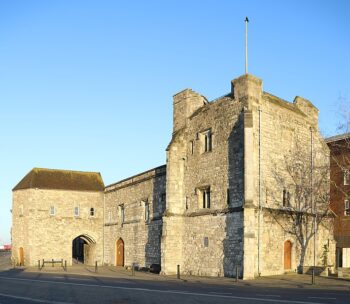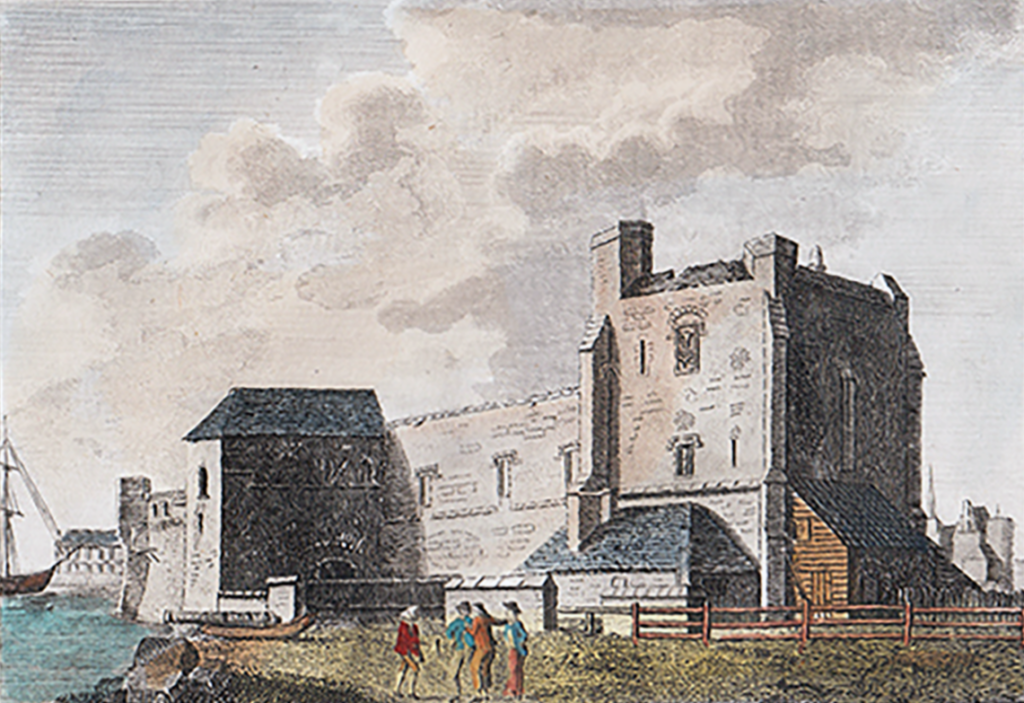
God’s House Tower was a medieval artillery fortification, designed to protect the south-east corner of the town of Southampton. The gateway was built around 1280, with a protective tower capable of housing cannon built close to it around 1400, which was then joined by a gallery in 1417, finishing the complex that survives today. Linked to the town walls, its cannon helped to protect Southampton harbour from potential French attack, and the tower also guarded the sluices that fed water into the town’s protective ditches.
By the end of the 16th century, there was less need for the fortification, which fell into disuse. In 1697, the town began to use the site as a prison, in which it continued in use up until 1850, when the insanitary conditions forced its closure in favour of a more modern facility. The surrounding land was drained and the site became a warehouse for the growing docks.
Between 1961 and 2011, God’s House Tower housed Southampton’s Museum of Archaeology. After a few years lying empty, it became a heritage venue in 2019. The site is protected under UK law as a Grade I listed building.
History
Background
By the time that the Normans conquered England in 1066, the town of Southampton occupied a rectangular area overlooking the mouth of the River Test, an important medieval waterway. It was protected by water on most sides and by protective ditches and banks to the north and east. Southampton at this time was a relatively large town, but not as significant as in the later medieval period.
In the south-east corner of the town, beyond the defences, was the town’s saltmarsh, stretching out to the shingle spit. A tidal mill operated at the mouth of the town’s ditch, powered by the sea. Around 1189, God’s House Hospital was established, serving travellers following the “Old Way” pilgrimage route to Canterbury. With a Franciscan Friary established in 1233 to the north of the hospital, the whole corner of the town acquired a distinctive, religious character.
13th – 15th centuries

Southampton grew as a trading location, and greater priority was given to its defences in the 13th century. Around 1280, God’s House Gate was built to enable access to the town. It had a portcullis and a vaulted passageway. Platform Quay was constructed in 1299, just within the protection of the new gatehouse. By 1320, Southampton was protected by a circuit of stone walls; a tower was built alongside God’s House Gate, linked to the walls, and the gatehouse enlarged. The gatehouse was sometimes used as a prison, and was defended with a springald.
By the 1380s, Southampton began to acquire gunpowder artillery. At this time cannon were still unreliable, only capable of reaching relatively short ranges and required the construction of specialist gunports. Cannons fired stone cannonballs, which did relatively little damage to stronger stone walls, and so were primarily used in defence of fortifications rather than as an offensive weapon by besiegers.
Fears of war with France around 1400 led to a tower being built to the east of the gatehouse, over the ditch and protecting the sluices that controlled the flow of water into them.1Around 1434, the tower was called the Mill Tower, since it over looked the mills in the ditch. It was designed to support gunpowder weapons, with gunloops on three sides for handguns, and embrasures on the roof for larger cannon. Fresh concerns of invasion led to further work around 1417, with a gallery or corridor being built linking the gatehouse to the eastern tower.
The result was that God’s House Tower formed a complete gun battery for defending the south-east corner of Southampton. It was one of the first of its kind in England, alongside Cow Tower in Norwich, and West Gate in Canterbury. The tower was used to hold Southampton’s arsenal – six guns in the 1430s, rising to twenty-five by the 1460s – with the gunpower stored in the cellar. The guns could be moved up to the Southampton Castle if necessary. Initially, the gunners at the tower were casually employed only when needed, and paid 6d a day.
16th-18th centuries

God’s House Tower continued in use as an artillery fortification into the reign of Henry VIII. The use of casual gunners had resulted in the artillery falling into bad repair, and Sir John Dawtrey, a powerful member of the local gentry, brought in German professionals instead, who became permanent employees of the town corporation. By the middle of the century, up to six gunner were employed, often doubling up as Town Sergeants, responsible for looking after prisoners and collecting tolls.
The need for the defences was demonstrated in 1542, when the French attacked Southampton with six ships, resulting in an artillery exchange that the town won, despite one gun exploding. The area around the tower was changing, however, as the Reformation of the Monasteries led to the close of the friary.
After this, however, the military value of the tower began to decline. During the 1540s, Henry constructed newer Device Forts further along the coast, controlling the entrances to the Solent with longer ranged guns. Any artillery confrontation with an invading navy was pushed further away from Southampton itself. International politics shifted too, reducing the likelihood of invasion.
By the 1590s, God’s House Tower had fallen into decay and any ongoing repairs were inadequate. Reports show that pikes were stolen from it, and a 1619 survey complained that the artillery pieces could no longer be moved due to their poor condition, and there was no gunpowder left in the arsenal. The lead was stolen from its roof and, with the ingress of water, rust became a major problem. By 1698, the writer Celia Fiennes observed that Southampton was now “a place of no strength”.
Traditionally, Southampton had used the Bargate as its main prison, but it had become increasingly full. In 1697, it was proposed to use the tower as a Bridewell prison for minor offences. A prison was established in the gatehouse, and the eastern tower used for purposes, including as a private hospital.
The Bargate remained crowded and complaints were made to the House of Commons. In 1760, the town decided to enlarge the prison at God’s House Tower, turning the first floor of the tower into a debtors’ prison. Bargate was finally closed in 1775, and a felons’ gaol for more serious criminals was established on the ground floor of the tower, at a cost of £140.
19th-21st centuries
The number of prisoners incarcerated at God’s House Tower increased through the first few decades of the 19th century. By 1830, 105 were sent there over the course of the year, rising to 585 by 1834, fuelled by the increasing numbers of smugglers being brought back to Southampton for sentencing. The crowded facilities were also suffering from the poor location: the sea made the rooms continually damp, and the town’s defensive ditch, now acting as an open sewer, still ran up to the tower. In 1850, inspections showed it was in a “most discreditable condition”, and plans were made to replace the facility. A new prison, costing £23,000, was constructed at Ascuparte Street between 1854 and 1855, and the tower was closed to inmates in 1855.
Meanwhile, the tower had been adapted to allow the cutting of a new canal. The plans for a canal to run from the coast, past Southampton to Salisbury and Andover had been made in 1795. The canal ran underneath the tower, using the same channel as the old town ditch. It was a commercial failure, odorous, and was criticised by locals as dangerous following various accidental falls into the channel. In 1841, the canal was filled in.
The neighbourhood around God’s House Tower was changing too. The saltmarshes were drained in the 1840s, the shoreline receded, and a new dock was constructed. A time-ball was built on top of the tower in 1888 to communicate an accurate time from Greenwich to the ships in the docks, which was powered by a combination electricity and clockwork. It lasted until it was removed in 1904.
In 1876, the tower was taken over as a warehouse by the Southampton Harbour Board. New doors were inserted through the medieval walls, and the surrounding buildings from its time as a prison were cleared away. Proposals to convert the building into the town mortuary and coroner’s court were put forward in 1891, but ultimately came to nothing. Instead, the tower remained in use as a warehouse until the 1930s.
The building increasingly fell into disrepair, becoming waterlogged and internally delipidated. The town corporation decided in 1957 to restore the tower as a Museum of Archaeology, which opened to the public in 1961 after a sequence of extensive renovations, at a cost of £17,471. The museum closed in 2011, and God’s House Tower reopened as an arts and heritage venue in 2019. The site is protected under UK law as a Grade I listed building.
Architecture
God’s House Tower comprises three linked buildings: the original gatehouse, the eastern gun tower, and the gallery joining the two. The buildings are constructed from stone rubble and have been extensively modified since their construction in the late-medieval period. The gatehouse has an arched, vaulted gateway, and was protected by a double portcullis. The main tower has three storeys, with gunloops and the potential to mount cannon on the higher floors – it has some architectural similarity to Cow Tower, in Lincoln, another early gunpowder fortification.
Bibliography
- Berger, L., J. W. Warner, H. R. G. Evenden, A. E. Carter and J. N. Calton. (1964) “Conversion of God’s House Tower, Southampton”, Official Architecture and Planning, Volume 27, Number 3, pp. 289-293.
- Brown, Richard and Alan Hardy. (2011) Trade and Prosperity, War and Poverty: An Archaeological and Historical Investigation into Southampton’s French Quarter. Oxford, UK: Oxford Archaeology.
- Burgess, L. A. (ed) (1976) The Southampton Terrier of 1454. London, UK: Her Majesty’s Stationery Office.
- Butler, Cheryl. (2020) Power, Prisoners and Paintings: The History of God’s House Tower. Southampton, UK: GHT.
- Creighton, Oliver Hamilton and Robert Higham. (2005) Medieval Town Walls: An Archaeology and Social History of Urban Defence. Stroud, UK: Tempus.
- Davies, J. Silvester (1883) A History of Southampton. Southampton, UK: Gilbert and Co.
- Pelham, R. A. (1963) The Old Mills of Southampton. London and Southampton, UK: Southampton Corporation.
- Turner, Hilary. (1971) Town Defences in England and Wales. London, UK: John Baker.
Attribution
The text of this page is licensed under CC BY-ND 4.0. Photographs on this page include those drawn from the Wikimedia website, as of 7 July 2023, and attributed and licensed as follows: “God’s House Tower“, by Geni, released under CC BY-SA 4.0.
